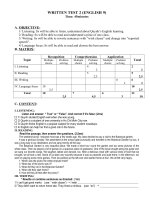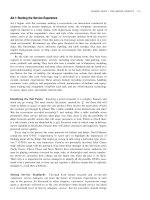Consumer behavior and marketing strategy 12e hawkins motherbaugh chapter 14
Bạn đang xem bản rút gọn của tài liệu. Xem và tải ngay bản đầy đủ của tài liệu tại đây (1.47 MB, 25 trang )
CHAPTER
14
Consumer
Decision
Process and
Problem
Recognition
McGraw-Hill/Irwin
Copyright © 2013 by The McGraw-Hill Companies, Inc. All rights reserved.
PART IV: CONSUMER DECISION PROCESS
14-2
Learning Objectives
L0
1
L0
2
Describe the impact of purchase involvement on the
decision process
Explain problem recognition and how it fits into the
consumer decision process
L0
3
Summarize the uncontrollable determinants of
problem recognition
L0
4
Discuss the role of consumer problems and problem
recognition in marketing strategy
14-3
Consumer Behavior In The
News…
I Didn’t Even Think About That!
Can you think of a “Inactive Problem” in Auto
Insurance?
Source: K. Patel, “Flo Thumbs a Ride with Drivers,” Advertising Age, March 14, 2011, p. 1.
14-4
Consumer Behavior In The
News…
I Didn’t Even Think About That!
Can you think of a “Inactive Problem” in Auto
Insurance?
One is that most companies charge an “average” rate
for a specific demographic which doesn’t account for
good driving habits. Not a problem most consumers
aware of.
Progressive now heavily touting its individual
monitor which tracks real-time driving and allows
motorists to get lower rates for “safer” driving.
Source: K. Patel, “Flo Thumbs a Ride with Drivers,” Advertising Age, March 14, 2011, p. 1.
14-5
Types of Consumer Decisions
Purchase involvement is
the level of concern for, or interest in,
the purchase process,
triggered by need to consider a
particular purchase, and so
it is a temporary state influenced by
the interaction of individual, product,
and situational characteristics.
14-6
Types of Consumer Decisions
14-7
Types of Decision Making
1. Nominal Decision Making
•
Brand Loyal Purchases
•
Repeat Purchases
2. Limited Decision Making
3. Extended Decision Making
14-8
Types of Decision Making
Nominal Decision Making
Nominal decision making, a.k.a., habitual decision making,
in effect involves no decision per se.
Nominal decisions occur when
there is very low involvement
with the purchase.
A completely nominal decision
does not even include
consideration of the “do not
purchase” alternative.
Consumer buys Campbell’s
without considering other
brands, its price, etc.
14-9
Types of Decision Making
Limited Decision Making
Limited decision making involves internal and limited
external search, few alternatives, simple decision rules on a
few attributes, and little postpurchase evaluation.
Middle ground between nominal
and extended decision making.
Involves recognizing a problem for
which there are several possible
solutions.
Decision based only on
buying the cheapest rolls.
14-10
Types of Decision Making
Extended Decision Making
Extended decision making involves extensive internal and
external search followed by a complex evaluation of multiple
alternatives.
It is a response to the high level
of purchase involvement.
During postpurchase evaluation,
doubts are likely and a thorough
evaluation takes place.
Emotional decisions may involve
substantial cognitive effort.
14-11
The Process of Problem Recognition
14-12
The Process of Problem Recognition
Types of Consumer Problems
Active Problem
An active problem is one the
consumer is aware of or will
become aware of in normal
course of events.
Inactive Problem
An inactive problem is one of
which the consumer is not
aware.
Marketing strategy:
Marketing strategy:
Only require marketer to
convince consumers that its
brand is the superior solution.
Marketer must convince
consumers that they have the
problem AND that their brand
is a superior solution.
14-13
Uncontrollable Determinants of
Problem Recognition
Nonmarketing Factors Affecting Problem Recognition
14-14
Marketing Strategy and Problem
Recognition
1. Discovering Consumer Problems
2. Responding to Consumer Problems
3. Helping Consumers Recognize Problems
4. Suppressing Problem Recognition
14-15
Marketing Strategy and Problem
Recognition
Discovering Consumer Problems
Identifying Consumer Problems Using Online and Social Media
Monitoring and tracking is not enough
Problems need to be solved in a timely and
appropriate manner
Samsung Consumer Problem – over 10,000 views!
YouTube Spotlight
14-16
Marketing Strategy and Problem
Recognition
Discovering Consumer Problems
Surveys and focus groups use one of the following
approaches to problem identification:
1. Activity Analysis
Focuses on a particular activity to determine what
problems consumers encounter during the
performance of the activity.
2. Product Analysis
Examines the purchase or use of a particular
product or brand. Consumers may be asked
about problems associated with using a product
or brand.
3. Problem Analysis
Starts with a problem and asks which activities,
products, or brand are associated with (or
perhaps could eliminate) those problems.
14-17
Marketing Strategy and Problem
Recognition
Discovering Consumer Problems
Human Factors Research
Human factors research attempts to determine human capabilities
in areas such as vision, strength, response time, flexibility, and
fatigue and the effect on these capabilities of lighting, temperature,
and sound.
Observational techniques such as slow-motion and timelapse photography, video recording, and event recorders
are particularly useful methods.
This type of research can sometimes identify functional
problems that consumers are unaware of.
14-18
Marketing Strategy and Problem
Recognition
Discovering Consumer Problems
Emotion Research
Marketers are increasingly conducting research on the role of
emotions in problem recognition and resolution.
Common approaches are surveys, focus group research
and personal interviews that examine the emotions
associate with certain problems.
Critical in helping marketers anticipate consumer reaction
to problems and train customer service personnel to
respond appropriately.
14-19
Marketing Strategy and Problem
Recognition
Responding to Consumer Problems
Once a consumer problem is identified, the manager may
structure the marketing mix to solve the problem.
This can involve:
• Developing a new product or altering an existing one
• Modifying channels of distribution
• Changing pricing policy, or
• Revising advertising strategy
14-20
Marketing Strategy and Problem
Recognition
Helping Consumers Recognize Problems
Generic versus Selective Problem Recognition
Generic Problem Recognition
•
•
Involves a discrepancy that
a variety of brands within a
product category can
reduce
Increasing generic problem
recognition generally
results in an expansion of
the total market
Selective Problem Recognition
•
Involves a discrepancy only
one brand can solve
•
Firms attempt to cause
selective problem
recognition to gain or
maintain market share
14-21
Video Application
The following Video Clip demonstrates
how numerous brands of bottled water
have benefited from generic problem
recognition!
14-22
14-23
14-23
Applications in Consumer Behavior
The Mack’s earplugs
ad shows how
marketers often
attempt to cause
consumers to
recognize potential
problems for which the
product provides a
solution.
Courtesy Mack’s® Earplugs.
14-24
Marketing Strategy and Problem
Recognition
Helping Consumers Recognize Problems
Suppressing Problem Recognition
Occasionally information is introduced in the market place that
triggers problem recognition that some marketers prefer to avoid.
Obviously marketers do not want their current customers
to recognize problems with their brands.
Effective quality control and distribution (limited out-ofstock situations) are important in this effort.
Packages and package inserts that assure the consumer
of the wisdom of their purchase are also common.
14-25









